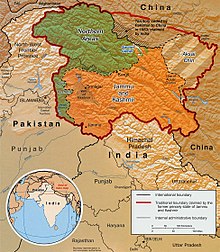Jammu and Kashmir (state)
 Shown in purple is the state of Jammu and Kashmir presently under Indian control. Indian border shown reflects total Indian claim. | |
| Date of formation | March 16, 1846 |
| Area | 100,569 km² administered by India 222,236 km² claimed by India |
| Population | 9,250,000 |
| Capital |
Srinagar Jammu |
| Governor (Indian state) | S.K. Sinha |
| Chief Minister (Indian state) | Mufti Mohammad Sayeed |

Jammu and Kashmir is the northern-most province of the Republic of India, with Srinagar as its capital and Jammu as its winter-capital. The Indian state consists of the Jammu, the Kashmir Valley and the Ladakh. Jammu and Kashmir is a historic state in the Indian subcontinent and is often called as the paradise on Earth because of its mountain-landscape. However, the ongoing terrorism and blood-shed has made it more of a flashpoint than a paradise. Jammu and Kashmir is a part of the Kashmir-disputed territory.
The Kashmir-disputed territory consists of 5 main areas: the Jammu and Kashmir, the Azad Kashmir, the Aksai Chin, the Northern Areas and the Siachen Glacier. The Government of India claims the entire area to be a part of India (as its northernmost state) including the area administered by Pakistan which it calls Pakistan Occupied Kashmir or PoK and the Aksai Chin, presently under Chinese occupation. Pakistan, however, does not recognize the region as being a part of India and calls the region under Indian control, i.e. Jammu & Kashmir, as Occupied Kashmir while the region under its control is called Azad Kashmir meaning Free Kashmir, except for the separately-administered Northern Areas.
India has granted Jammu and Kashmir a special autonomy status, however Kashmiri political parties demand for a greater autonomy and sovereignty. Jammu and Kashmir has two main political parties : People's Democratic Party (PDP) and the National Conference. Presently, PDP is the ruling party with Mufti Muhammad Sayed as the Chief Minister of the state. PDP and its ally the Congress Party hold the maximum number of seats in the assembly.
While Jammu is a Hindu majority area, the Kashmir Valley is predominantly Muslim and Ladakh has a Buddhist-majority population. It is this complex demography of the region which has been the main cause the ongoing Kashmir Dispute.
The Indian government prohibits any publication describing the area as a disputed territory as opposed to an integral part of India, which, for example, has led to a ban on the import of Encyclopædia Britannica CD-ROMs into India in 1998 [1].
The Kashmir Dispute
main article (Indo-Pakistani War of 1947)
Jammu and Kashmir was a princely state with a Muslim majority ruled by a Hindu Maharaja (king) until 1947. In 1947, when the Indian subcontinent achieved independence from Britain, the Maharaja could not decide whether to join India or Pakistan. Soon after the independence, Pathan tribesman from Pakistan's North Western Frontier, invaded the state. With no defence forces and increasing incidents of Human Rights abuses, the Maharaja was compelled to ask India for help and decided to acede the state to New Delhi, following which National Conference's Shiekh Abdullah became the head of the Kashmir State government. By January 1948, Indian troops landed in the region and claimed the territory as a part of the Union of India. Furious Pakistan, immediately invaded Kashmir. After months of intense fighting, both the nations agreed on a cease-fire, separating the region into two: Indian-controlled Jammu and Kashmir and Pakistan Occupied Kashmir. In 1961, China invaded India and occupied the north-eastern region of the country known as Aksai Chin, which India continues to claim as its part.
Ever since, a bitter enimity has been developed between India and Pakistan. The two countries have been to war three times in Kashmir (1947-1949, 1965, 1971) and clashed there again during the Kargil Conflict of 1999. The region remains as one of the most heavily militarised zones in the world. The de facto situation is that Pakistan controls just under half, China a small portion, and India just over half the state.
Terrorism in the State has claimed more than 45,000 lives of innocent Kashmiri civilians from 1988 to 2000. Independent organisations, however, put the total casualties at a much higher figure.
See also
- Kashmir
- India
- Terrorism in Kashmir
- Border Security Force
- Indo-Pakistani War of 1947
- List of political parties in the state
